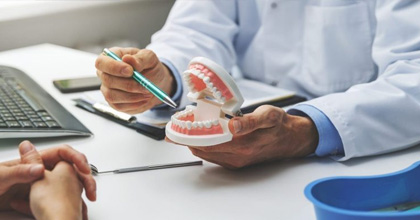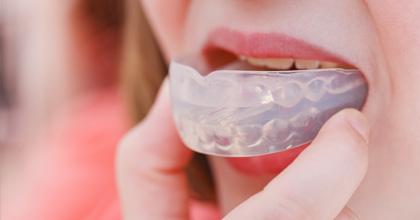If you're experiencing jaw pain, frequent headaches, clicking sounds, or difficulty chewing, you may be suffering from TMD, a disorder related to the TMJ (temporomandibular joint).
At Happy Braces Orthodontics, we specialize in diagnosing and treating TMJ disorders with non-invasive, orthodontic-based solutions to relieve discomfort and restore proper function.

What Is Obstructive Sleep Apnea?
Obstructive sleep apnea occurs when soft tissue in the throat or an underdeveloped jaw blocks the airway during sleep. This leads to pauses in breathing, often followed by choking or gasping. These episodes can happen dozens—even hundreds—of times per night.
Why Patients Seek TMD/TMJ Treatment
- Jaw & Facial Pain Relief
TMD can cause soreness or stiffness in the jaw, neck, and face. Treatment can help eliminate chronic discomfort and improve daily function. - Headache & Migraine Reduction
TMJ-related tension often leads to frequent headaches. Addressing bite misalignment can reduce these painful episodes. - Improved Bite Function
When the jaw joint isn’t working properly, eating, speaking, and even yawning can be uncomfortable. Orthodontic care can realign the bite for smoother jaw movement. - Protects Teeth from Damage
Chronic grinding (bruxism) associated with TMD can wear down teeth over time. Treating the underlying cause helps prevent long-term dental damage

What Is TMD?
Temporomandibular Disorder (TMD) refers to a group of conditions that affect the jaw joint (TMJ) and surrounding muscles. This joint connects your lower jaw to your skull and allows you to speak, chew, and move your jaw. TMD can develop from misalignment, injury, stress, or habits like teeth grinding
Common Symptoms of TMD
- Jaw pain or tenderness
- Clicking, popping, or grinding sounds
- Difficulty opening or closing the mouth
- Frequent headaches or migraines
- Earaches or ringing in the ears (tinnitus)
- Neck or shoulder tension
- Tooth sensitivity from grinding
What to Expect During Treatment

Comprehensive Evaluation
Dr. Babak Yousefi will examine your bite, jaw alignment, and joint movement. We may take digital X-rays or 3D scans to assess the joint and surrounding structures.

Diagnosis & Personalized Plan
If TMD is diagnosed, we’ll develop a customized treatment plan that may include bite correction, jaw alignment, or therapeutic appliances.

Custom Orthodontic Appliances
We may recommend a nightguard or orthotic splint to relieve tension, reduce grinding, and support the joint as it heals

Orthodontic Realignment
If bite issues are contributing to your symptoms, braces or aligners may be recommended to correct misalignment and improve long-term jaw function.

Ongoing Monitoring
We’ll track your progress and make any needed adjustments to ensure your comfort and recovery
Common Questions
What causes TMD?
TMD can be caused by bite misalignment, jaw injuries, arthritis, teeth grinding, or stress-related jaw clenching
Do I need braces to treat TMD?
Not always. Many patients find relief with oral appliances or physical therapy. Braces or aligners may be recommended if your bite is contributing to the problem.
How long does TMD treatment take?
Relief from symptoms can begin within weeks, though full treatment may take several months depending on the severity.
Is TMD treatment covered by insurance?
TMD treatment may be covered by medical or dental insurance. Our team will help you navigate your coverage and payment options.







